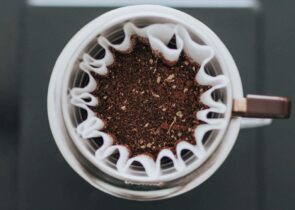Competent coffee preparation involves a mix of knowledge, skill, and experience. Experienced coffee lovers can appreciate the level of technical skill required to brew the perfect espresso. The perfect cup of espresso comes only after thoroughly practicing your barista technique, and a good understanding of your equipment is a foundational requirement.
When it comes to espresso, picking the proper brew setup can be tricky. Let’s examine the common types of espresso machines to introduce some clarity.

Pump vs. Steam Espresso Machines
Making a good espresso shot requires at least an introductory knowledge of brew time, water temperature, pressure, and grind size. Balancing these factors is both an art and science, and a well-trained barista spends many hours perfecting their espresso-based beverages. Frankly, it’s hard to reach your peak coffee-making level without the right equipment.
Broadly speaking, we can break espresso machines into two broad categories: pump machines and steam machines. However, there is an important caveat. Technically speaking, steam machines aren’t espresso machines at all.
Despite the “steam” name in their title, they generate minimal steam pressure compared to pump-driven machines.
So why compare these two different pieces of coffee brewing equipment? Well, many coffee aficionados put their espresso grind into steam-driven espresso machines and are quite pleased with the result.
Even though steam espresso makers can’t follow the rules for brewing espresso precisely, they can still produce a nice-tasting espresso.
Steam Espresso Machines
We’ve already mentioned that one of the cons of steam espresso machines is they cannot produce traditional espresso. They lack pressure due to lacking a built-in pumping element.
The most common form of steam brewers, called Moka pots, can only produce one-to-two atmospheres of pressure. The pot then uses this pressure to drive boiling water through the coffee grind to create the final drink.
Though electric steam brewers are available today, the original Moka pot design was intended to be used on a stovetop or over a campfire. The heat from the stove or fire boils water in the pot, forming it over the top of a water tank and through the ground coffee.
Veteran coffee lovers may recognize that this brewing method is used in another well-known piece of coffee equipment: percolators. Percolation is a controversial coffee-making process.
On the one hand, it is a simple, effective way to get a cup of coffee. On the other hand, it can be challenging to control the brewing process.
Steam espresso machines do have some differences when compared to percolators. Generally, steam espresso machines contain a filter element designed for finely ground espresso, whereas percolators generally accommodate a larger, coarser grind.
Another critical difference between steam espresso machines and traditional percolators is the lack of recirculation. Percolators continually circulate hot water around the grind; there is no separate water tank.
Once the water moves through the coffee grounds in steam brewers, however, the brewing process is done; it cannot reenter the brewing chamber.
So why do we call these kinda-percolators “espresso machines”? Besides being designed for a fine espresso grind, they produce a rich, flavorful cup of coffee similar to espresso in taste and mouthfeel.
Steam machines are quite capable of producing a fresh, delicious shot of coffee. On the right hand, this type of espresso machine can produce excellent results at a fraction of the cost of pump espresso machines.
Pump Espresso Machines
A pump espresso machine has a built-in pump to pressurize the heating water. As with most modern coffee machines, the pump can be automatic or manual, which requires the barista to pump up the required pressure by hand.
Most professional and consumer types of espresso machines contain an electric pump and sensor, which automatically builds up the selected, ideal pressure in the machine. While steam espresso machines operate at around one-to-two atmospheres of pressure, a pump-driven machine can produce upwards of 15 atmospheres of pressure.
The general consensus is that nine atmospheres of pressure are best for excellent espresso brewing. A machine capable of higher pressures gives the user more control of the brewing process.
For example, once you hone your barista skills, you may wish to fine-tune your espresso by starting with a brief burst of high pressure before tapering to a lower pressure for brewing.
This is where we find the debate surrounding steam espresso machines. Without adding a pump to achieve espresso pressure, is it an authentic espresso?
That debate is settled with a pump espresso machine, which will produce, at a minimum, the nine atmospheres of pressure required, brewing true, unimpeachable espresso every time.
It is worth noting milk-frothing capabilities, which are tied to an espresso machine’s ability to create high pressure.
Steam espresso machines do not have a steam wand or any other method for steaming and frothing milk (although there are ways around this). Pump espresso machines use the excess pressure from the brewing water to steam milk.
While all but the worst pump espresso machines will reliably produce a halfway decent espresso, chasing the perfect shot can come at a cost. Pump espresso machines are more complicated and therefore more expensive than their steam-driven cousins.
Top Steam Espresso Machine Picks
Here are a couple of our top picks for pumpless espresso machines.
Zulay Classic Stovetop Espresso Maker
The Zulay brings a classy image to the traditional Moka pot style. This espresso maker is designed to be used in the home on the stovetop. It features a simple, dependable design that is easy to clean and maintain. The brewing capacity is relatively small at five ounces, but this should be plenty for one or two people.
Pros:
- Extremely affordable
- Easy to use
- Fully disassembles for cleaning
Cons:
- Limited control over the brewing process
- Small brewing capacity
Bialetti New Brikka Moka Pot
The Bialetti is similar to other Moka pot designs. However, the Bialetti claims to be the only stovetop coffee maker that can truly replicate the crema of espresso coffee.
Explicitly designed to emulate traditional espresso, the Bialetti is an excellent option for those just starting to brew espresso at home. The generous four espresso-cup capacity increases the utility beyond similar stovetop coffee brewers.
Pros:
- Brews crema-rich coffee similar to espresso
- Cheaper than pump-driven espresso machines
- Easy to clean
Cons:
- Limited control over the brewing process
- Long brewing time
Top Pump Espresso Machine Picks
Here are some of the top home-use contenders among pump espresso machines.
Gevi 15 Bar Espresso Machine
The Gevi is an affordable, accessible pump espresso machine perfect for beginners. The high-power heating element heats brewing water quickly, and the automatic pump can produce up to 15 bars of pressure. A large dial thermometer gives an accurate, easy-to-read indication of brew temperature.
The Gevi also includes a steaming wand. Users can set two different temperatures — one for the brewing water and one for the steam wand. The top surface of the brewer warms as the machine operates and is intended as a space to warm espresso cups. The Gevi offers professional brewing at amateur prices.
Pros:
- Dual thermostats to control your brew and milk-frothing easily
- High-powered heater for quick operation
- High-pressure pump for quick and stable extraction
Cons:
- Small parts are difficult to disassemble for cleaning
- Compact size can make large brews difficult
Yabano High-Pressure Espresso Machine
No products found.
The Yabano is another semi-pro espresso rig aimed at home users. A powerful pump produces higher pressure for ideal brewing, and the dual-drip portafilter allows for the filling of two espresso cups at once. The Yabano contains an adjustable milk frothing arm to position as needed.
The top of the Yabano espresso machine can also double as a cup warmer. The large, easy-to-read pressure gauge makes it easy to see the operation of the espresso machine. Unlike many espresso machines, the Yabano’s water tank is removable, making adding brewing water a breeze.
Pros:
- Professional, durable design in compact form factor
- Removable water tank
- High-pressure adjustable pump for the ideal brewing pressure
Cons:
- Steam wand temperature and brewing temperature are not separately adjustable
- Parts are not dishwasher safe and must be hand-cleaned
Wrap Up
Overall, choosing between a steam espresso machine and a pump espresso machine comes down to two primary factors: cost and utility. If you want an affordable espresso machine that makes a rich, tasty shot of coffee that confidently mimics espresso, a steam machine will likely do a fine job at a fraction of the cost of a pump espresso machine.
Steam espresso machines won’t be a good fit for espresso aficionados, however. The control over the brew is too limited, and it is easy to over-extract the grind. Pump espresso machines are ideal for the semi-professional barista, and a range of models with varying features are available.
The art of espresso takes practice. No matter which style you choose, you will need to invest some time into perfecting your technique. Steam espresso machines offer a great entry point before investing in the more expensive pump espresso machines.
Happy Caffeinating!










